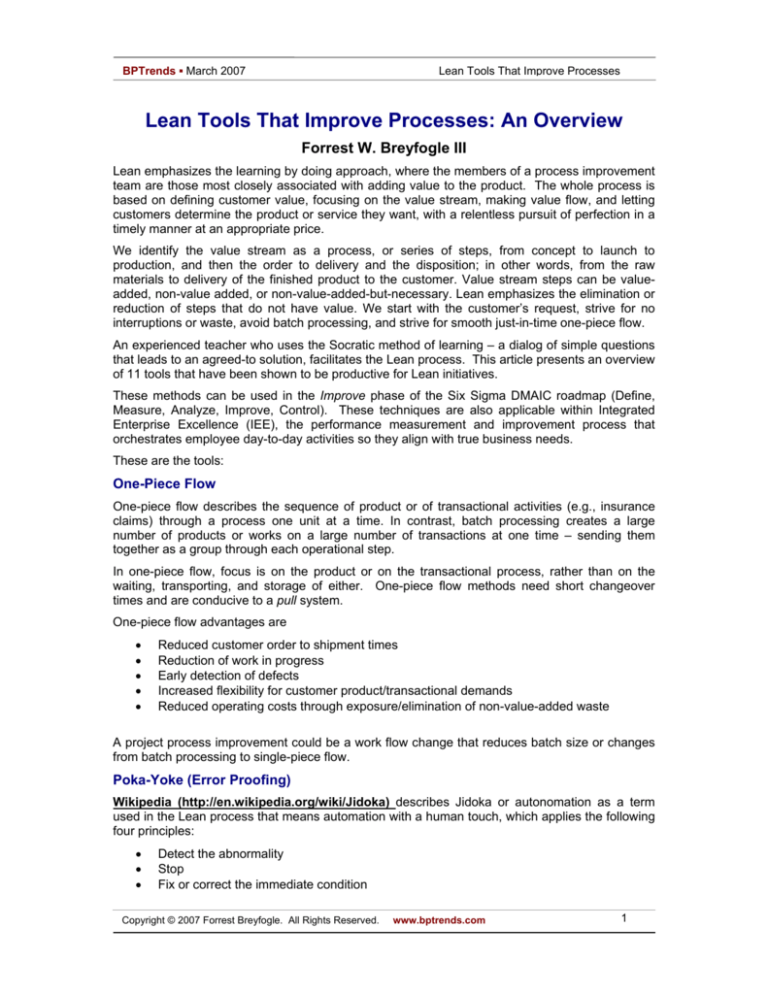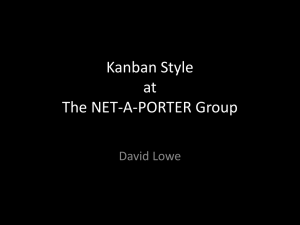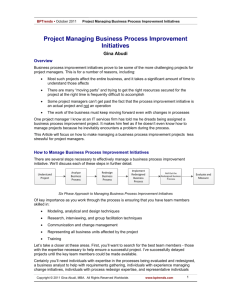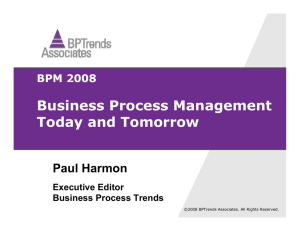
BPTrends ▪ March 2007
Lean Tools That Improve Processes
Lean Tools That Improve Processes: An Overview
Forrest W. Breyfogle III
Lean emphasizes the learning by doing approach, where the members of a process improvement
team are those most closely associated with adding value to the product. The whole process is
based on defining customer value, focusing on the value stream, making value flow, and letting
customers determine the product or service they want, with a relentless pursuit of perfection in a
timely manner at an appropriate price.
We identify the value stream as a process, or series of steps, from concept to launch to
production, and then the order to delivery and the disposition; in other words, from the raw
materials to delivery of the finished product to the customer. Value stream steps can be valueadded, non-value added, or non-value-added-but-necessary. Lean emphasizes the elimination or
reduction of steps that do not have value. We start with the customer’s request, strive for no
interruptions or waste, avoid batch processing, and strive for smooth just-in-time one-piece flow.
An experienced teacher who uses the Socratic method of learning – a dialog of simple questions
that leads to an agreed-to solution, facilitates the Lean process. This article presents an overview
of 11 tools that have been shown to be productive for Lean initiatives.
These methods can be used in the Improve phase of the Six Sigma DMAIC roadmap (Define,
Measure, Analyze, Improve, Control). These techniques are also applicable within Integrated
Enterprise Excellence (IEE), the performance measurement and improvement process that
orchestrates employee day-to-day activities so they align with true business needs.
These are the tools:
One-Piece Flow
One-piece flow describes the sequence of product or of transactional activities (e.g., insurance
claims) through a process one unit at a time. In contrast, batch processing creates a large
number of products or works on a large number of transactions at one time – sending them
together as a group through each operational step.
In one-piece flow, focus is on the product or on the transactional process, rather than on the
waiting, transporting, and storage of either. One-piece flow methods need short changeover
times and are conducive to a pull system.
One-piece flow advantages are
•
•
•
•
•
Reduced customer order to shipment times
Reduction of work in progress
Early detection of defects
Increased flexibility for customer product/transactional demands
Reduced operating costs through exposure/elimination of non-value-added waste
A project process improvement could be a work flow change that reduces batch size or changes
from batch processing to single-piece flow.
Poka-Yoke (Error Proofing)
Wikipedia (http://en.wikipedia.org/wiki/Jidoka) describes Jidoka or autonomation as a term
used in the Lean process that means automation with a human touch, which applies the following
four principles:
•
•
•
Detect the abnormality
Stop
Fix or correct the immediate condition
Copyright © 2007 Forrest Breyfogle. All Rights Reserved.
www.bptrends.com
1
BPTrends ▪ March 2007
•
Lean Tools That Improve Processes
Investigate the root cause and install a countermeasure
A poka-yoke is a mechanism that works with Jidoka to either prevent a mistake or make a
mistake obvious at a glance; for example, an operator who creates customized assemblies from
small bins in front of him: One approach would be to give the operator a list of parts to assemble
by taking them as needed from the bin. This approach can lead to assembly errors since he or
she might forget to include one of the parts or add parts not specified. A poka-yoke solution might
be to install lights on all bins. When the operator is to create a new assembly, the bins that
contain the specified parts for the assembly will be illuminated. The operator then systematically
removes one part from each bin and places it in front of him. He does this until one part has been
removed from each bin and he knows the assembly is complete when no parts remain in front.
Poka-yoke offers solutions to organizations that experience frequent discrepancies in the
packaging of their products – e.g., someone forgot to include instructions or forgot to include a
mounting screw. Poka-yoke ideas or devices can be more effective than simple demands on
workers to “be more careful.” Improvement focus should always be given to what can be done to
error-proof a process more than on inspecting the quality of the finished product.
Visual Management
Visual management can address both visual display and control. Visual displays present
information, while visual control focuses on a need to act. Information needs to address items
such as schedules, standard work, and quality and maintenance requirements. Visual control can
address whether a production line is running according to plan; it can highlight problems.
In both manufacturing and transactional processes, visual management systems can include
Visual management techniques:
•
•
•
Expose waste for elimination/prevention
Increase visibility and use of operational standards
Enhance efficiency through an organized workplace
Visual management organizations:
•
•
•
•
Improve quality through error prevention, detection, and resolution
Increase workplace efficiency
Improve workplace safety
Reduce total costs
The 5S Method
Creation of standardized work is a primary reason for using the 5S method. It offers a basic
housekeeping discipline for the shop floor and the office. It includes the following five steps: Sort,
Straighten, Shine, Standardize, and Sustain.
Sort: Clearly distinguish what is needed or not needed among the tools, supplies, and other
materials.
•
•
Tag items if not used within a month, or that are unnecessary to perform a task, or that
are broken or not usable, or insufficient for an intended purpose.
Manufacturing: List all red-tagged items on a sheet of paper. Remove the red-tagged
items and place them in an identified red-tag storage area. All items must be reviewed by
the supervisor and initialed – if approved for removal.
Straighten: A marked space exists for all items in the work area, allowing for easy, immediate
removal.
Copyright © 2007 Forrest Breyfogle. All Rights Reserved.
www.bptrends.com
2
BPTrends ▪ March 2007
•
Shine:
•
•
Lean Tools That Improve Processes
Organize remaining items in the work area by usage. Label daily usage items on a
shadow board. Place weekly usage items in labeled drawers, placing monthly usage
items under the work station or in a cabinet labeled with pictures and text.
Work area is cleaned and kept in an orderly condition during working hours.
Determine what needs to be done to create a visually attractive workplace. Keep the
workstation clean and plan a weekly 10-minute cleaning maintenance for each area.
Manufacturing illustration: Clean tools and paint machines as needed. Sweep floor.
Tighten any loose fittings. Create specific cleaning instructions for the work environment,
including which cleaning supplies to use and where. Add maintenance items to monthly
schedule.
Standardize: Work method, tools, and identification markings must be standard and recognizable
throughout the factory. 5S methods are to be applied consistently in a uniform and disciplined
manner.
•
•
Identify source for waste disposal. Workers must look at their jobs and machines while
performing tasks to see where debris is created. Create discipline to prevent individuals
from becoming the source of waste.
Manufacturing: Check machine(s) for oil leaks, standardize maintenance, and check for
broken but functional switches that need repair.
Sustain: 5S is a regular part of the working process with continuous actions required to maintain
and improve the production environment. Established procedures are maintained with checklists.
Areas must be kept clean so that everything is clearly identified as required or unnecessary.
•
•
A maintenance list should be developed and discipline maintained.
Create a check list that includes tagged items removed from the work station. List
remaining items and locations, document steps for the cleaning process, and list action
items for preventive maintenance.
Value Stream Mapping
Value stream mapping, or material and information flow, should play a very productive role in the
entire Lean process since practitioners depict current and future conditions when they develop
plans to install Lean systems. Infinite attention should be given to establishing flow, eliminating
waste, and adding value.
Kaizen
Kaizen is another pervasive tool since it is a focused methodology that uses teams for making
improvements. If analysis indicates that this is the best systematic approach for an improvement
project, then a Kaizen event should be undertaken. A continuous improvement process that
empowers people to use their creativity, Kaizen can be used to fix specific problems, workflow
issues, or a particular aspect of a business.
Based on quantitative analysis, a good starting point is to look at the way people work –
identifying waste through a time and motion study of tasks with input from both workers and
managers. Generic steps for conducting a Kaizen event are
Prepare and train the team:
During event preparation, identify problem cells and select the cell that will be given focus. This
work should have been done in the early stages if it is within an overall corporate/operational IEE
project execution roadmap. Assemble the team and, if necessary, conduct training on waste
control, standardized work, and continuous flow.
Copyright © 2007 Forrest Breyfogle. All Rights Reserved.
www.bptrends.com
3
BPTrends ▪ March 2007
Lean Tools That Improve Processes
Analyze present methods:
The team uses a videotape to analyze the cell in action to determine material flow, cycle time, cell
layout, process waste, and other vital measurements. During this time they can generate a
standardized work and work combination table. The team needs to record the current number of
operations over time, and the defect rates. Photographs should be used to document the overall
Kaizen event.
Brainstorm, test, and evaluate ideas:
Divide the team into smaller groups to discuss ways to improve the cell, using the compiled work
cell analysis statistics. Groups then test potential improvement tactics on the work cell, assessing
their impact. Results from the tested ideas are shared with other team members. This keeps
other groups from making similar mistakes and inspires new ideas. This cycle may be performed
many times before desired results are achieved.
Implement and evaluate improvements:
After the team has developed its plan for achieving results, a maintenance request is generated,
if necessary, where modifications are fully described so that management can authorize
change(s) to the work cell and its processes. All of the working personnel are then trained in the
new process by Kaizen team members. Improvements are monitored, and progress is video
taped and standardized. Results are measured and items that require additional time are put on a
future 30-day action list to be implemented by the team.
Results and follow-up:
Team members document all improvement items and compile results to determine monetary
savings, improved space utilization, and time reductions. Team members make a presentation to
top management with a commitment to complete outstanding items. Management recognizes the
team’s performance and makes suggestions for the future.
Kanban
A system that creates product that is then sold after it is produced is called a push system. If
there is no mechanism to keep work in work-in-progress below some level that is consistent with
product demand, production output can become excessive, which can lead to many problems,
including product storage.
In pull systems, products are created at a pace that matches customer demand. Kanbans are
used to buffer variations in customer or next process step demands. A most familiar form of
kanban is the American-style supermarket where each product has a short-term buffer,
replenished at the rate of customer demand. The Japanese word kanban refers to the pulling of
a product through a production process. The intent of kanban is to signal a preceding process
that the next process needs parts or material.
A bottleneck is a system constraint. In a pull system, the bottleneck should be used to regulate
the pace for the entire production line. Buffers in high-volume manufacturing serve to balance the
line. It’s important that such operations receive the necessary supplies in a timely basis and that
poorly sequenced work does not interfere with the process completion. Pull systems address
what the external and internal customers need when they want it.
Rules to consider when operating an effective kanban:
•
•
•
•
No withdrawal of parts is to occur without a kanban where subsequent processes are to
withdraw only what is needed.
Defective parts are not to be used for later processes
Preceding processes are to produce only the exact quantity of parts withdrawn by
successive processes.
Variability in the demand process should be minimized.
Copyright © 2007 Forrest Breyfogle. All Rights Reserved.
www.bptrends.com
4
BPTrends ▪ March 2007
Lean Tools That Improve Processes
If production requirements drop off, the process must be stopped. An increase in production
requirements is addressed through overtime and process improvement activities within the IEE
discipline.
Kanban can dramatically improve a process that produces few defects within workstations.
However, if there are workstations that have high defect rates (i.e., a hidden factory), the system
can become “starved” for parts. This problem could be avoided by integrating kanban with an IEE
measurement and improvement system.
Kanban can be the relay signal between supplier and customer. Kanban signals can be
generated by lights, colored balls down a tube, or a computer network. A food market can know
when to stock by keeping track of product-volume sold through a barcode system. A stock
person responds to a product pull by replenishing the prescribed number using first-in, first-out
product restocking. The supplier knows the volume of product to supply because of the kanban
system.
Kanban “label” data can include
•
•
•
•
•
•
•
•
•
Kanban number
Supplier name
Line site address: location of line where the component will be processed
Shipping area address: shipping location for finished assemblies
Part store address: factory location for temporary storage of components before
assembly line use
Part description
Quantity in kanban package
Bar code
Part number
Demand Management
Demand Management works best when there is a uniform flow of products within the system.
While a company’s policies should encourage stability, unfortunately that is not always the case.
For example, a reward system for product sales might encourage a spike in manufacturing
demands at the end of each month.
If these signals are ready incorrectly, it can lead to supply chain problems in the form of an
inaccurate product forecast. Accounting procedures can encourage management also to produce
excess inventory in order to make the number on which they are evaluated look better.
Supply chain improvements can be expected when lead times are reduced, which would improve
forecasting accuracy, and when there is a sharing of supply-chain information that leads to
agreement-to uniform schedules.
Another improvement opportunity is to change internal policies that impact demand volume. For
example, consider an end-of-the-month/quarter sales-target bonus policy that results in the sales
department giving temporary price concessions so they meet their monthly/quarter sales targets.
This policy could be a candidate for change, since the sales-force reward policy may be causing
a manufacturing demand peak that leads to much overtime and quality issues.
Heijunka
Heijunka is a traditional Lean scheduling methodology for environments that contain a repetitive
mix of products, or a family of products. Heijunka is a kanban card post-box system that is usually
at the pacemaker process. A Heijunka box provides process level scheduling/pacing, schedule
visibility, and early problem highlighting.
Copyright © 2007 Forrest Breyfogle. All Rights Reserved.
www.bptrends.com
5
BPTrends ▪ March 2007
Lean Tools That Improve Processes
Leveled production is customer order averaging so that small sequenced cycles produce the
required volume and product mix. In a Heijunka box, customer monthly or weekly volume
demands can be leveled into daily demands.
Pull systems and Heijunka work well hand-in-hand. However, system improvement may be
needed for success, e.g., through quick change over. When the visual system indicates a
problem, prompt identification and correction are absolutely essential.
Continuous Flow and Cell Design
The disadvantages of traditional batch production are the large amounts of work in progress,
large conveyance time for parts, large lead times, and large liability for defects.
Small lot production removes the walls from batch production, and reduces work in progress, lead
times, and conveyance. It can be impossible, however, to balance task durations for machine
operations with this push system since one operator can spend a great deal of time waiting, and
inventory can build up at a station.
Within U-shaped layouts, employees are cross-functionally trained and move with changing cell
layouts. This means that one person can control the work in progress. Close proximity of workers
also enhances communications, makes quick defective part detection possible, and workload
adjustments can be made for volume changes.
Changeover Reduction
One of Lean’s major objectives is reduction of lead time. To achieve this, the size of batches
often needs reduction, which, in turn, creates a focus on reducing changeover times – i.e., the
time from the last piece of one batch to the first piece of the next batch.
Changeover time can have several components; e.g., internal, when a machine is stopped, and
external, which involves preparation. Other types of changeovers are manufacturing line
changeover, maintenance operations, vehicle/aircraft loading/unloading, and office operations.
The classic changeover is, of course, the Grand Prix pit stop! It’s important not only to reduce the
mean changeover time, but also to reduce its variability using a standardized process.
Moving internal activities to external ones, when possible, permits more up time for a machine
since the maximum amount of preparation is accomplished before it is stopped. Example
applications for improving external activities are placing tools on carts near a die and using color
codes to avoid confusion. Example applications for improving internal activities are quick-change
nuts and standardization of activities.
Lean Tools and Six Sigma: The Relationship
Traditionally, Six Sigma is a project-based methodology led by Black and Green Belts who work
with teams of area experts and those involved in overall day-to-day enterprise operations. Lean
movers and shakers believe their hands-on approach works better than a single project-based
approach led by Black and Green Belts. The general consensus seems to be that Six Sigma
project execution takes longer, but is more sustainable than most Lean events.
Overall, the revolutionary Integrated Enterprise Excellence (IEE) management system offers
more than either Lean or Six Sigma. IEE tightly interconnects all corporate and operational
processes, using the strengths of both Lean and Six Sigma so that each methodology is used at
the right time in the right way to achieve the right result relative to true measured and quantified
business needs.
_______
Copyright © 2007 Forrest Breyfogle. All Rights Reserved.
www.bptrends.com
6
BPTrends ▪ March 2007
Lean Tools That Improve Processes
Author
Forrest Breyfogle is the founder and CEO of Smarter Solutions, Inc. www.smartersolutions.com,
and creator of the Integrated Enterprise Excellence system. He is a Professional Engineer, an
ASQ Fellow, and serves on the board of advisors for the University of Texas Center for
Performing Excellence. He received the 2004 Crosby Award for his book, Implementing Six
Sigma, 2nd ed. Mr. Breyfogle began his career with IBM, in development, and later transferred to
the firm’s product test organization. Within these organizations he became very interested in the
benefits from the wise use of statistical techniques. From 1980 to 1992 he served IBM in applying
Six Sigma methodology to testing, development, manufacturing, and service organizations.
Contact the author at forrest@smartersolutions.com.
Copyright © 2007 Forrest Breyfogle. All Rights Reserved.
www.bptrends.com
7








